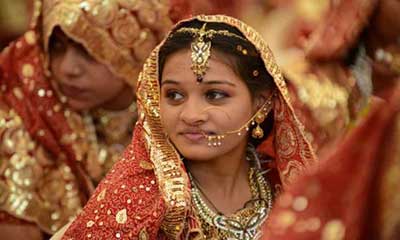GS-2 Welfare Schemes for Vulnerable Sections of the population by the Centre and States and the Performance of these Schemes; Issues Relating to Development and Management of Social Sector/Services relating to Health, Education, Human Resources.
Key Phrases: Sharda act, Hindu marriage act, prohibition of child marriage act
Why in news?
Cabinet clears push to raise marriage age of women from 18 to 2
Analysis:
What is current status?
- According to a recent report published by State Bank of India, 35% of females in India are married before the age of 21 years. In West Bengal, the mean marriage age is only 20.9 years and almost 47 per cent of females get married before the age of 21.
- For Hindus, The Hindu Marriage Act, 1955, sets 18 years as the minimum age of marriage for the bride and 21 years as the minimum age for the groom. However, child marriages are not illegal even though they can be declared void at the request of the minor
- In Islam, the marriage of a minor who has attained puberty is considered valid.
- Special Marriage Act, 1954 and the Prohibition of Child Marriage Act, 2006 also prescribe 18 and 21 years as the minimum age of consent for marriage for women and men respectively.
Do we benefit by raising marriage age?
- Socio-economic front: Increasing the legal age of marriage for women has enormous benefits on social and economic fronts including: Lowering the Maternal Mortality Ratio (MMR), Improvement of nutrition levels etc.
- Financial front: Opportunities will be opened up for women to pursue higher education and careers and become financially empowered.
- Higher female labour force participation: increasing the marriage age will push the mean marriage age higher and will lead to more females doing graduation and hence improving the female labour force participation ratio.
- For 5 trillion economy target, we need to use every bit of labour in our economy and women are part of it.
- There is a need to bring in gender-neutrality as different age for men and women leads to a psychological inequality. In a consultation paper of reform in family law in 2018, the Law Commission argued that having different legal standards “contributes to the stereotype that wives must be younger than their husbands”.
- In 2014, in National Legal Services Authority of India v Union of India, the Supreme Court while recognizing transgender as the third gender said that justice is delivered with the “assumption that humans have equal value and should, therefore, be treated as equal, as well as by equal laws.
- In 2019, in Joseph Shine v Union of India, the Supreme Court decriminalised adultery and said that “a law that treats women differently based on gender stereotypes is an affront to women’s dignity.”
- A study conducted by the International Food Policy Research Institute (IFPRI), which was published in 2019, showed that children born to adolescent mothers (10-19 years) were 5 percentage points more likely to be stunted (shorter for their age) than those born to young adults (20-24 years).
- Girl children often face situations of bonded labour, enslavement, commercial sexual exploitation and violence as a result of child marriage.
But, do we really need to increase it?
- Misuse of law by parents: The law has been used by parents against eloping daughters. It has become a tool for parental control and for punishment of boys or men whom girls choose as their husbands.
- Increased female infanticide: Moreover, raising the female marriage age in the countries that have high son preference and high poverty may have the unintended consequence of increasing the prevalence of female infanticide.
- UNICEF estimates suggest that each year, at least 1.5 million girls under the age of 18 are married in India. Nearly 16% adolescent girls aged 15-19 are currently married. Instead of preventing this a new law seems like an exercise in vacuum
- Child and women’s rights activists, as well as population and family planning experts have not been in favour of increasing the age of marriage for women on the basis that such a legislation would push a large portion of the population into illegal marriages.
- law would end up being coercive, and in particular negatively impact marginalised communities, such as the Scheduled Caste and Scheduled Tribes, making them law-breakers.
Way ahead
- Altering the thinking: Any ground-level change will only happen when the psyche of people will alter. No law is effective if change does not occur from within.
- Erasing the stereotype: Increasing the legal age for marriage is a must, even legally as it should get us out of the stereotype mindset that women are more mature than men of the same age and therefore can be allowed to marry sooner.
- Reconsidering the time limit for repudiation: As far as the issue of repudiation of marriage by girls is concerned, it should be changed from two to four years. Thus providing more time to rethink over the marriage.
- Jaya Jaitley committee setup to recommend increasing age of marriage asked the government to look into increasing access to schools and colleges for girls, including their transportation to these institutes from far-flung areas. Skill and business training has also been recommended, as has sex education in schools
- Extending the scope of the Right to Education for girls up to vocational studies.
Source: Indian Express
Mains question:
Q. Assess the impact of globalisation on the dynamics of marriage in India. Is marriage still a sacrament? (10 Marks, 150 Words)









